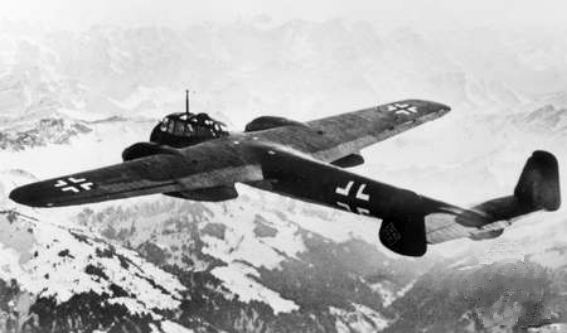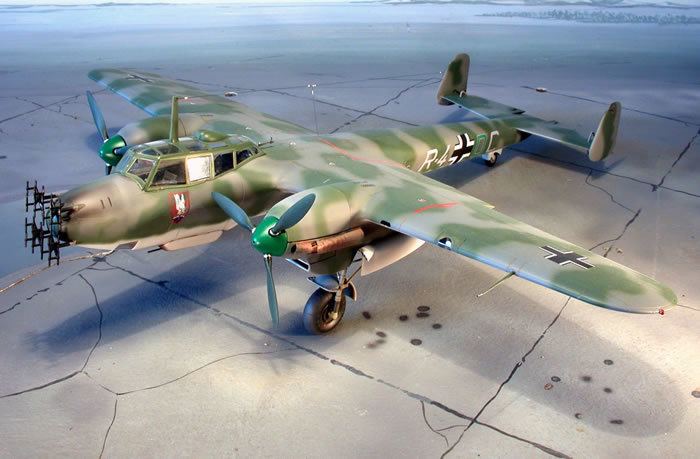Top speed 345 km/h Wingspan 18 m Weight 5,209 kg First flight 1938 | Range 1,160 km Length 16 m Engine type Daimler-Benz DB 601 | |
 | ||
Die reibert wochenschau dornier do 215
The Dornier Do 215 was a light bomber, aerial reconnaissance aircraft and later a night fighter, produced by Dornier originally for export, but in the event all except two served in the Luftwaffe. Like its predecessor, the Dornier Do 17, it inherited the title "The Flying Pencil" because of its slim fuselage. The successor of the Do 215 was the Do 217.
Contents
- Die reibert wochenschau dornier do 215
- Design and development
- Operational history
- Variants
- Operators
- Surviving aircraft
- Specifications Dornier Do 215 B 1
- References

Design and development
The Do 17 fast bomber elicited renewed interest from foreign air forces (after the initial Do 17K series production). In July 1937, Dornier therefore prepared a pre-series Do 17 Z-0 as a demonstrator for export customers. It was given the civil registration D-AAIV. While this aircraft was essentially identical to the production Do 17Z, the Reichsluftfahrtministerium assigned the designation Do 215 to the export version. The V1 prototype retained the 9-cylinder Bramo 323 Fafnir radial engine of the Do 17Z.

The second prototype (Do 215 V2) was equipped with Gnome-Rhône 14-NO radial engines. It safely completed testing, but did not attract export orders because it did not offer a notable performance increase over the Do 17Z. Dornier therefore equipped the V3 prototype with the 1,175 PS (1,159 hp) Daimler-Benz DB 601Ba inline engines. much like the 1937 fitment of the earlier DB 600 powerplants to the Do 17L and M subtypes. The V3, which first flew in the spring of 1939, showed a noticeable improvement in flight performance compared to the earlier prototypes.

Series production of the Do 215 A-1 began in 1939. The order, intended for the Swedish Air Force, was stopped in August 1939 due to the political situation. The 18 extant aircraft were embargoed and pressed into Luftwaffe service upon the outbreak of World War II.
Some modifications were made and the resulting aircraft were redesignated Do 215B. This was the standard production version. According to official figures 105 Do 215s were produced between 1939 and 1941 by Dornier in their factory at Oberpfaffenhofen.
Operational history

The Luftwaffe initially operated the Do 215 as a bomber and reconnaissance aircraft. Aircraft equipped with the Rb 20/30 and Rb 50/30 cameras were used for long-range reconnaissance missions, primarily at the Ob.d.L (Oberkommando der Luftwaffe). Later aircraft operated as night fighters. The last of the Do 215s were retired in late 1944.
Variants
Of the versions of the Do 215 that existed, the A-1 bomber with DB 601 engines, and the B-0 and B-1 export machines both re-equipped with FuG 10 navigation device for the Luftwaffe. The Do 215 B-5 was the first night fighter to be equipped with the FuG 202 Lichtenstein B/C navigation device. These aircraft saw action from January 1941 to May 1944 with I. and IV./NJG 1 and II./NJG 2.
Operators
Surviving aircraft
Up until recently, none of the Dornier twin-engined bomber variants were thought to have survived. In September 2007, a Dornier Do 215 B was found largely intact in the shallow waters of the Waddenzee, the Netherlands. This aircraft was flown by a Luftwaffe fighter ace Helmut Woltersdorf. On the night of 6/7 July 1941 Woltersdorf shot down a Vickers Wellington but his Dornier was damaged by return fire and crash landed off the Dutch Coast. The area where the Dornier came down was named as a seal sanctuary and thus it escaped the attentions of scrap merchants and souvenir hunters. At low tide the aircraft becomes visible. The Aircraft Recovery Group from the Airwar Museum at Fort Veldhuis in Heemskerk received permission to partially recover the Do 215. The only missing part of the aircraft is the tail section which lies 70 ft (21 m) to the rear of the main wreckage. The Daimler-Benz DB 601 engines were recovered along with the starboard portion of the cockpit.
Specifications (Dornier Do 215 B-1)
Data from German Aircraft of the Second World War.
General characteristics
Performance
Armament
